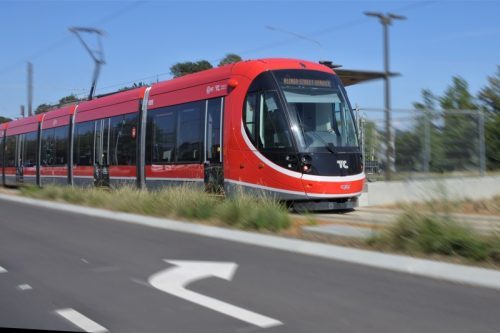
“If you thought that on the strength of the business case and Light Rail Stage 1 that no fiscally responsible government would or should have proceeded with the project, wait until you see the business case for Stage 2,” writes JON STANHOPE
TAXPAYERS Australia Limited, also known as Tax and Super Australia, celebrated its centenary in May through the presentation of the inaugural Galah Awards for the most wasteful expenditure programs by governments in Australia.

The awards were sponsored by the Taxpayers Research Foundation Limited and received nominations from the Commonwealth and all states and territories.
Tax and Super Australia explains that the Galah Awards are so named because: “Galahs are pink and grey raucous parrots, but as the Australian Museum once provided on its website, ‘we call people galahs if they are acting silly or do something foolish’.” These nominations for the Galah Awards are clear examples of what foolish things governments can do.”
There were three Galah Award categories, namely: Category 1 for the worst implemented program; Category 2 for the most expensive and inefficient program; and Category 3 for the worst implemented program.
There were a total of 43 nominations from across Australia. Two of these were from the ACT, for Light Rail Stage 1 and the Ngunnawal Bush Healing Farm.
In a large and extremely competitive field of marginal, problematic, ideologically driven, pork-barrelling or otherwise unjustifiable projects the Taxpayers Research Foundation Limited awarded the ACT government the Galah Award – Highly Condemned, in Category Two, which was for the most expensive and inefficient program in Australia, for Light Rail Stage 1. The ACT was pipped for the major title in this category, the Ultimate Loser Award, by the infamous NSW Baby Bundles scheme.
As the ACT government ramps up preparations for the commencement of Light Rail Stage 2, it is probably timely to review the most salient features of the successful nomination of Stage 1 for a Galah Award as a guide to how Stage 2 might fare if nominated in the future for an award in its own right in the toughly contested competition for the most expensive and inefficient program in Australia.
The following excerpts from the formal nomination of Light Rail Stage 1 for a Galah Award would, therefore, one imagines, have clearly been central to the project receiving its Highly Condemned Award.
“The project, delivered under a PPP has a whole-of-life nominal cost of $1.78 billion and present value cost (2016) of $939 million discounted at 7.52 per cent. However, these costs do not include estimated agency costs associated with the construction and operation of the light rail. Under the partnership, the government will pay $375 million in capital contribution, $1.27 billion in availability payments over 20 years and retain $129.7 million of risks. The government will also carry the patronage and fare box risk.”
“A cost benefit analysis prepared in 2012 estimated a benefit-cost ratio (BCR) of 1.02 for the light rail project and 1.98 for a bus rapid transit. The BCR’s were reported in a submission to Infrastructure Australia.
“A subsequent business case released in 2014 estimated a BCR of 1.2 for light rail and 2.4 for the bus rapid transit alternative.
“The BCR estimate for light rail, however, was misleading. It included land value uplift and wider economic benefits, which are notably excluded by Infrastructure Australia in its assessment of the benefits of such projects. Excluding those benefits, as they should be, the BCR for the light rail project was according to the ACT auditor-general in 2016 a mere 0.49.
“To proceed with a project where the return is less than 50 cents for every dollar spent is simply not consistent with the nationally accepted cost benefit rules. Notably the BCR reported by the auditor-general was likely an overestimate as the audit pointed out that apart from the excluded agency costs, considerable work for the business case had not been completed including, but not limited to the utility services which needed to be relocated.
“In an ACT Legislative Assembly hearing, project officials advised that those costs could be in the order of $200 million.
“Financial analysis of the project released after the project was committed to indicated that significant development along the corridor would be required, along with land sales, value capture mechanisms and an increase in taxes in order to recover the financial costs of the project.
“Along the corridor, 1288 public housing dwellings were demolished. The government allocated $192 million in 2016 for the replacement of the lost stock. These costs were not included in the business case or the CBA.”
I accept that if one reads the above summary of the business case, financial implications and budget impact of Light Rail Stage 1 really quickly it seems quite benign and unremarkable. It is also, of course, to the uninitiated, little more than mumbo jumbo and it is not surprising that the response of most of us when reading technical guff such as this is to simply turn the page before our eyes glaze over.
The Galah Awards might be seen as little more than a bit of frivolous and harmless fun and hence easily dismissed. That would, however, be a mistake. They are deadly serious and if you, like many of us, have thought that on the strength of the business case and BCR for Light Rail Stage 1 that no fiscally responsible government would or should have proceeded with the project, just wait until you see the business case and BCR for Stage 2.
Who can be trusted?
In a world of spin and confusion, there’s never been a more important time to support independent journalism in Canberra.
If you trust our work online and want to enforce the power of independent voices, I invite you to make a small contribution.
Every dollar of support is invested back into our journalism to help keep citynews.com.au strong and free.
Thank you,
Ian Meikle, editor




Leave a Reply